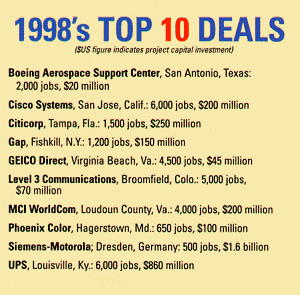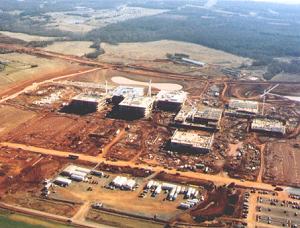| |
From Site Selection magazine, May 1999 1 9 9 8 ‘ s T O P 1 0 D E A L S Dovetailing Development Excellence
In these 10 deals, you’ll find the facility location strategies that have fueled corporate giants that run an inordinately wide industry gamut, from Boeing to UPS. That broad swath takes in disparate industries including aerospace, book publishing, clothing, express mail, finance, high tech, insurance and telecom. These 10 deals do, however, share a commonality. In each case, development groups inventively dovetailed their efforts with corporate strategies, creating the kind of congruence essential in making major corporate location projects happen. The fruits of that development excellence are prodigious. 1998’s “average” top 10 deal will create 3,125 jobs and a capital investment of US$346 million. With time, those numbers may escalate substantially, for many of these deals were done with a sharp eye toward future expansion. At least when it comes to attracting major corporate facilities, diversification certainly seems to have its benefits. And resounding ones they are. T E X A S Boeing Aerospace Support Center, San Antonio, Texas, $20 million, 2,000 jobs Many job bases shrank as the Cold War thawed. San Antonio qualified after 1995’s announced closing (to be finalized in 2001) of Kelly Air Force Base. It lost 1,200 high-end jobs alone in 1997’s relocation of the military’s C-5 maintenance to a Georgia base. San Antonio, though, has taken flight with Boeing’s landing at Kelly AFB after a site search that began in late 1997. The Greater Kelly Redevelopment Corp., which has spearheaded the base’s economic rebirth, led the recruitment effort, along with the San Antonio Economic Development Foundation, a local development ally. They offered Boeing an enticing prospect: a 1-miilion-sq.-ft. (90,000-sq.-m.) hangar. And the Texas Dept. of Economic Development, collaborating with the local team, designed an aggressive incentive package emphasizing work-force training. What they landed is a new Boeing. The new San Antonio operation is the hub of Boeing’s new move into aircraft maintenance/modification, a service thrust the Texas river city has complemented nicely. “Lots of communities with Air Force bases closing would’ve loved a Boeing facility,” says Mark Owen, Aerospace Support Division vice president/general manager. “In San Antonio, though, we’re in exactly the right place at the right time, with the facilities, infrastructures, business environment, quality of life and work force.” Always a major factor, work-force skills were critical in siting Boeing’s service hub, where the premium is on speed, high quality and low costs. San Antonio workers have delivered big-time with advanced skills that cut the original six-week training program to only two weeks. Boeing rapidly went online in August 1998 with 220 workers. Already, it’s ramped up to 1,200 employees, with 2,000 workers and “24-7” production projected for year-end 2000. Local labor looks ready. Coinciding with a local flood, Boeing’s late-1999 job fair drew a deluge of some 2,300 area applicants. Says Owens, “There are a lot of skilled people here ready to go to work” — the stuff of site selectors’ dreams. C A L I F O R N I A  Cisco Systems, San Jose, Calif., $200 million, 6,000 jobs Cisco Systems, San Jose, Calif., $200 million, 6,000 jobs An unusual public-private partnership was the catalyst that kept fast-growing Cisco Systems’ massive expansion in California. The networking products powerhouse had to move fast. Cisco was literally bursting at the seams in its local area facilities, not surprising given that the company’s annual revenues have increased more than 10-fold in eight years, while its Silicon Valley work force has tripled in only four years. Obviously, a company to keep. But the deal nearly destructed over a road extension from Cisco’s current San Jose complex to the new property it coveted; the extension’s $16 million price tag made some politicos shiver. In the meantime, Cisco was looking at other sites, particularly its existing Research Triangle Park, N.C., operation, to accommodate its vital growth. “We’d like to do business here. We value knowledge-worker proximity, but things are easier in North Carolina,” one Cisco executive confided. That was when development officials in the cities of San Jose and Milpitas joined with state officials and Cisco to forge the partnership that sealed the deal. Cisco paid $90 million for the state-owned 139-acre (56-ha.) site in north San Jose, but the state and the two cities will provide $20 million in infrastructure improvements, most dedicated to roadwork. The payoff for this development proactivism, however, is substantial. For example, San Jose alone will add $3.5 million a year to tax coffers with the new Cisco complex, which will be phased in over 10 years. F L O R I D A Citicorp, Tampa, Fla., $250 million, 1,500 jobs Citicorp’s 1,500-employee Tampa expansion is the largest facility location project in Hillsborough County’s history, which is going a ways, considering that Progressive Insurance, Oxford and Chase Manhattan already each employ more than 1,000 area workers. Citicorp already had a major corporate presence in Tampa, headquarters for two Citibank divisions: Worldwide Operations and Technology, and Business Services. Other sites, however, came in for strong consideration, including Atlanta, Dallas and New York City. Tampa, though, worked hard and worked closely with Citicorp to land the project. Says Joe McCarthy, Citicorp Realty Services vice president, “Over the past six years, the Tampa Committee of 100 has literally served as an extension of our staff as we have refined our plans for Citibank Center Tampa,” a 700,000-sq.-ft. (65,000-sq.-m.) complex with its own postal code, which McCarthy calls “a prototype year 2005 model for Citibank worldwide.” Key factors in Tampa’s win included local development officials’ offsetting impact fees of $1 million (based on 1,000 new jobs at $1,000 each), employee training grants of $338,000 and low area business costs, particularly for labor, company officials say. Tampa also provided a fast track for Citicorp’s expansion within its existing “development of regional impact,” a state-approved classification that provides pre-permitted sites for office developments exceeding 300,000 sq. ft. (27,000 sq. m.). Citicorp’s Tampa presence could expand even further through consolidations within Citigroup, the giant created by the Citicorp-Travelers merger. If this deal is prologue, newcomers can expect a warm welcome. “The Committee of 100’s corporate relocation team made numerous trips to New York City to inform prospective | |
| for us,” Level 3 CEO James Crowe says of the survey. “We wanted a city that would [help] attract and retain the highly specialized work force we need.” Other major location factors for Level 3 included the area’s quality education infrastructure, its international airport and local living costs far lower than in many high-tech hotbeds, easing employees relocations. Continuing Colorado’s frugality, location incentives weren’t a major factor. Infrastructure improvements, for example, begin only after Level 3’s local tax revenues begin rolling in. But, then, Level 3 has $4 billion in capital and assets and a $17 billion-plus market capitalization — pocketbook clout it will need. Level 3 is boldly building the first international phone network optimized for Internet technology. It’s already rolling out operations in 25 U.S. cities and has opened its international gateway in London. With the huge Broomfield hub holding things together, Level 3 looks fully loaded to take on telecom’s big boys. V I R G I N I A MCI WorldCom, Loudoun County, Va., $200 million, 4,000 jobs
In fact, the MCI acquisition changed this $200 million, 4,000-employee operation’s location. Prior to the merger, MCI planned a 2,000-employee operation in neighboring Fairfax County. With the merger, the company decided to consolidate MCI’s planned expansion with WorldCom’s previously announced Loudoun County project, which will house information technology operations and the headquarters for UUNet, MCI WorldCom’s mission-critical Internet subsidiary. “The quality of this area’s employees, with a lot of divergent skills, is as good as we’ve come across anywhere, [and] it was very difficult, with our rapid growth here, to renew leases or rental space at rates that you can stay in business with,” says MCI WorldCom CEO Bernard Ebbers. The roomy, 543-acre (217-ha.) site facilitates MCI WorldCom consolidating other area operations and provides opportunities to sell off parcels to other firms eager to be nearby. The Loudoun County Dept. of Economic Development’s fast-track work, which landed America OnLine’s headquarters in 1997, was a major determining factor. The group is providing a $1 million, six-land road linking the campus to the Dulles Greenway, plus $3 million for area road improvements. State economic development officials have pledged $2 million in assistance, $1 million originally slated for the Fairfax site. “This decision further confirms Loudoun and Northern Virginia’s reputation as the entire Washington metro’s economic engine,” says Virginia Gov. James Gilmore III. As large as it is, though, the project may be but a small first step. Long term, MCI WorldCom says it may employ as many as 20,000 at the site. M A R Y L A N D Phoenix Color; Hagerstown, Md.; $100 million, 650 jobs Among 1998’s top 10 deals, Phoenix Color’s expansion in its headquarters city of Hagerstown, Md., will likely have the greatest proportional economic impact, adding 650 jobs to Washington County’s service area of 130,000 people. Phoenix Color’s expansion, however, was never wedded to its headquarters city. A number of Pennsylvania sites, plus its other plants in Long Island City, N.Y. and Taunton, Mass., were reportedly considered. A major factor in Phoenix’s pick was the Hagerstown-Washington County Economic Development Commission’s (EDC) commitment to existing businesses, company officials say. In fact, Phoenix Color Chairman Louis LaSorsa made the expansion announcement at a special EDC breakfast meeting where EDC Director John Howard was outlining his group’s “strategic priorities for 1998.” The first priority listed: “emphasize the development of existing businesses.” Local and state officials worked closely with Phoenix throughout its search to make the project happen on an 80-acre (32-ha.) site near the Washington County Regional Airport — whose proximity was also a major factor. The county is building a $1.5-million corporate aircraft hangar and then leasing it to Phoenix. Local development officials also provided infrastructure assistance with the site, where Phoenix Color will build a “Book Technology Park” including a complex of facilities focused on different aspects of book manufacturing. “We recognized that this was a competitive opportunity to win or lose,” says Washington County Commissioners Board President Gregory Snook. “These jobs are both high in quality and higher paying than many in the region.” G E R M A N Y Siemens-Motorola; Dresden, Germany; $1.6 billion, 500 jobs With this joint venture, Siemens and Motorola move to the forefront in 12-inch (300-mm.) wafer manufacturing. While IBM has pioneered 12-inch wafer production, the semiconductor industry has lagged in moving into volume production, a slowdown on which this international project capitalizes. Some analysts, however, say that the 12-inch production leader faces too high a price. Others strongly disagree, including George Lee of the Semiconductor Equipment and Materials International trade association. Larger wafers will allow the two firms to produce some 2.5 more chips per wafer, while cutting costs an estimated 30 percent for existing eight-inch (200-mm.) wafers, he explains. “Motorola and Siemens may pay now, but they may get to higher yields quicker,” Lee adds. “Why wouldn’t you want to be first? It’s like being the only race car on the track. You are going to win as long as you finish the race.” Cost-sharing, incentives and available capacity played major roles in the decision, company officials say. “We had some space left in Dresden, with manufacturing infrastructure already in place, due to economic conditions,” explains Ulrich Schumacher, CEO of Siemens’ semiconductor group. “And we wanted to do the pilot line in a manufacturing environment, with real comparisons with 200-mm. wafers.” Following guidelines to promote economic development in the former East Germany, the German state of Saxony is providing $70 million toward the project’s capital investment. The German Ministry of Education, Science, Research and Technology is providing grants of $110 million for the start-up of the R&D investment of some $600 million. “Both companies are making a statement that they intend to lead,” says Hector Ruiz, president of Motorola’s semiconductor products sector. “I think people will look back as Dresden as the initiative that enabled the industry to get moving in the 300-mm. direction.” The joint venture will also get 12-inch manufacturing moving faster to other Motorola and Siemens plants, perhaps as early as 2001, the companies say.
K E N T U C K Y  UPS, Louisville, Ky.: $860 million, 6,000 jobs UPS has delivered big-time for Louisville and Kentucky. Last year, Louisville and Kentucky delivered big-time for UPS, greasing the skids for the delivery giant’s huge project, which will generate 6,000 jobs and a capital investment of $860 million. “Community political and business leaders looked beyond the seven airplanes and 250 jobs we originally brought [to Louisville]. They were able to see a future where the fabric of the global economy would be held together by a high-tech distribution and logistics systems, which in 1981 was just being born,” says UPS Airlines President Tom Weidemeyer. Indeed, UPS has long ranked as “a critically important corporate citizen,” with its major presence acting as a facility location magnet says Dough Cobb, president of Greater Louisville Inc. (formerly the Chamber of Commerce). The biggest corporate expansion in Kentucky’s history, UPS’ mammoth center, which will be one of UPS’ rare connection points for next-day worldwide delivery, will also expand Louisville’s appeal to international businesses. To facilitate the expansion, the Kentucky General Assembly passed a new $1 million cap on the state tax on jet fuel, which will save UPS $3 million a year. Other project incentives include a $35 million income tax break. A public-private partnership will also create a special campus to bolster the availability of college student workers, UPS’ preferred part-time labor pool. UPS, the University of Louisville, The University of Kentucky’s Jefferson Community College and Kentucky Tech will jointly set up the campus, offering college and technical courses designed to fit the hub’s 11-p.m.-to-5-a.m. shift. SS | |
|---|---|
| |
 | Site Selection Online | SiteNet |
|


 Diversification may be dead when it comes to business focus. Not so, though, for 1998’s top 10 deals, selected by Site Selection‘s editorial staff in extremely intense competition.
Diversification may be dead when it comes to business focus. Not so, though, for 1998’s top 10 deals, selected by Site Selection‘s editorial staff in extremely intense competition. MCI WorldCom (see this issue’s cover story) had a problem last year. Its crazy-quilt growth in Northern Virginia added up to too much dispersal and too few economies of scale, problems intensified by WorldCom’s $40 billion acquisition of MCI in late 1998.
MCI WorldCom (see this issue’s cover story) had a problem last year. Its crazy-quilt growth in Northern Virginia added up to too much dispersal and too few economies of scale, problems intensified by WorldCom’s $40 billion acquisition of MCI in late 1998. 